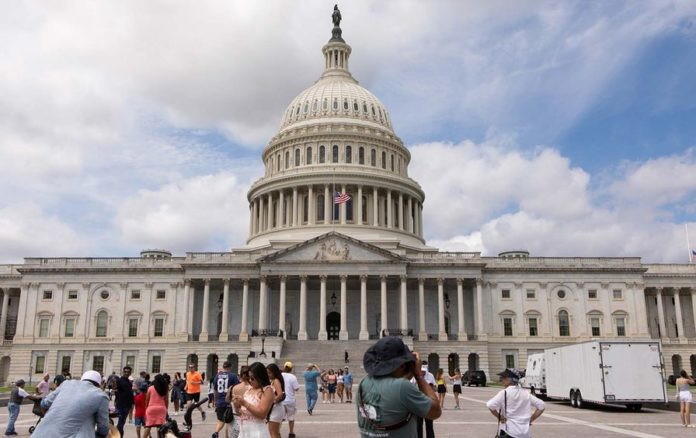For a second, it looked like a pretty stark difference. When Democrats introduced a series of bills to the House this month, each designed to codify in statute a particular kind of sexual freedom, the vote counts were unnervingly partisan. The Women’s Health Protection Act, a bill that would codify a federal right to an abortion, received no Republican votes. HR 8373, an unnamed bill to protect legal access to contraception, received just eight Republican votes. But the Respect for Marriage Act, which would require states to recognize same-sex and interracial marriages, received a comparatively robust 47 Republican votes.
It’s not exactly a ringing endorsement of same-sex marriage from the Republican Party. But still, the asymmetry between Republicans’ support for reproductive rights and their support for gay marriage is striking. Even as homophobia, and particularly, transphobia mounts on the right wing, marriage equality has maintained more support within the Republican Party. Why?
It’s not because of the polling. Though support for abortion rights is a notoriously difficult to measure, the best estimates suggest that something like two-thirds of Americans support legal abortion. Pew Research recently put the figure at 61 percent. That’s not far off the public support for gay marriage, which also enjoys the backing of a sizable majority of the public: about 70 percent, according to Pew. Is it that gay marriage is more popular with Republican voters? It is, but not by much: 44 percent of Republican voters say that support gay marriage, while 38 percent say that abortion should be legal in all or most cases. If Republicans were following the will of the people more broadly, their positions would be radically different. If they were following only the will of their own voters, then more of them would support abortion rights.
It’s not a philosophical difference, either. After all, the two issues are not so ideologically different. Any honest account acknowledges that the movements for reproductive freedom and gay rights are inseparably linked—mutually interdependent, and proceeding from the same principles. In an ardent and loving recent obituary for the gay rights activist Urvashi Vaid, the writer Masha Gessen recounted a conversation that Vaid had with the AIDS activist Larry Kramer that summarized the connection. “That’s the issue of reproductive choice,” Vaid told Kramer. “It was never about men should march with women because they support women. It was more that men should march for reproductive freedom because we’re marching against the power of the state to tell you and me what to do sexually.… If the state can say you can’t have an abortion, the state can say you can’t have sodomy.” At their core, the demands made by each movement are much the same: that the sexed body must not constrain the possibilities for a person’s life.
But if abortion rights and gay marriage rights are intrinsically linked, why is one currently being attacked so much more viciously than the other? One answer is simple: It’s the misogyny, stupid. Men benefit from gay marriage; it affords them freedom and social power. But most of the freedom and power afforded by abortion rights goes to women. But sexism, though an essential part of the equation, seems like an incomplete answer. It’s also a matter of the content of the ask. Wanting an abortion is, in some ways, a fundamental rejection of an ancient order of power that says people’s destinies must be determined by their bodies. But wanting to get married is a comparatively nonthreatening ask: It’s about wanting access to an ancient and essentially conservative institution. One of these desires is something people on the right can relate to; another is something they hate and fear.
It’s not that no one has tried to show the human side of abortion. Over the past 10 years, the reproductive rights movement has disavowed the stigmatizing language of “safe, legal, and rare,” and has begun talking about abortion as an affirmatively pro-social good. Groups like WeTestify have adopted first-person abortion storytelling as a central messaging strategy, betting on both the expertise of abortion storytellers and on their public appeal. Sometimes, the abortion rights movement has even emphasized abortion’s role in preserving institutions like marriage and the family, leaning heavily on the true, but questionably relevant, reality that most people who have abortions are already mothers, or advancing the stories of women who say that their abortions made them better wives and better parents. But this strategy has been most successful in shaping how the abortion rights movement presents itself to patients and constituents, not in changing how abortion as an issue is understood by elites. “Everyone loves someone who’s had an abortion,” goes the slogan, but this destigmatizing effort seems to do little to sway Republican elites, who still consider abortion, and the women’s freedom that it creates, something unpleasant and sinful—something to be regretted and forgiven, not something to be thankful for.
Not so with gay marriage, which has always had a different cast. This idea was echoed by Kierra Johnson, executive director of the National LGBTQ Task Force. “The movement was able to say to the people in power, ‘The face of gay marriage looks just like you.’” Reproductive rights, on the other hand? “Those people just don’t see themselves in the experiences of women & others who seek abortions,” she told me.
That they could see themselves in the experiences of gay people isn’t an accident. The LGBT rights movement of the 2000s and 2010s was deliberate at selecting the most palatable messengers for their cause: People who had markers of class privilege, people who had stable, monogamous relationships, people who had lots of education and prominent positions. Not exclusively, but frequently, these people were male. Almost always, they were elites—elites, that is, like the politicians who decided their fates. The movement chose its faces carefully. For everything else she embodied, Edie Windsor, the plaintiff in the Supreme Court case that eventually secured federal recognition of gay marriages, was also a creature that Republicans could relate to intimately: the heir to a large fortune, who was outraged at her tax bill.
At a Pride Month dinner thrown by the Justice Department in 2014—something of a victory lap for the LGBT legal movement after the prior year’s victory in Windsor v. United States—the lawyer Pamela Karlan, an out lesbian and, at the time the assistant attorney general for civil rights in the Obama DOJ—told a story that illustrates this point. She was describing a moment at the Supreme Court in 2003, just after the oral arguments in Lawrence v. Texas. “I was standing in the well of the court with Walter Dellinger,” Karlan told the dinner guests. “Linda Greenhouse, who was then the New York Times’ Supreme Court reporter, came over. ‘What did you think was the most interesting part of the argument?’ Walter asked. Without missing a beat, Linda replied, ‘The bar section.’ What she meant was this. A huge proportion of the gay, lesbian and bisexual former clerks and of LGBT members of the Supreme Court bar had showed up. And when the Justices came out from behind the velvet curtain, you could actually see them reacting to our presence as their eyes swept across the courtroom.”
The justices were confronted with the reality that gay people were people like them, people they knew and liked—powerful people, rich people, lawyers. The result was that they ruled in those people’s favor, a ruling that happened to be on the side of justice. Maybe it is not flattering to the marriage equality movement to point out that much of its success is owed to moments like this, to the ability of gay elites to remind powerful politicians of themselves. But it is the truth. It is hard to imagine a similar scene unfolding at the Supreme Court for Dobbs v. Jackson, with all the Supreme Court lawyers and ex-clerks who had had abortions staring down the court. This is not because powerful elites don’t have abortions. It’s because they risk more than gay elites do in saying so.








